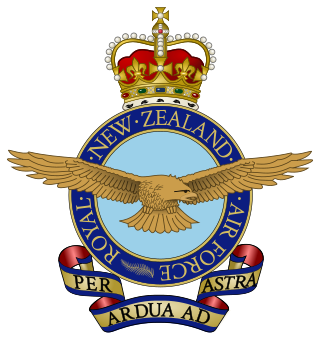
The Royal New Zealand Air Force is the aerial service branch of the New Zealand Defence Force. It was formed initially in 1923 as a branch of the New Zealand Army, being known as the New Zealand Permanent Air Force, becoming an independent air force on 1 April 1937.

The Lockheed Hudson is a light bomber and coastal reconnaissance aircraft built by the American Lockheed Aircraft Corporation. It was initially put into service by the Royal Air Force shortly before the outbreak of the Second World War and primarily operated by it thereafter. The Hudson was a military conversion of the Model 14 Super Electra airliner, and was the first significant aircraft construction contract for Lockheed — the initial RAF order for 200 Hudsons far surpassed any previous order the company had received.
No. 75 Squadron of the Royal Air Force operated as a bomber unit in World War II, before being transferred to the Royal New Zealand Air Force in 1945. This remains the only time in RAF’s history that a squadron was gifted to another commonwealth Air Force.

No. 488 Squadron was the name given to two distinct Royal New Zealand Air Force squadrons during the Second World War. Both were formed under Article XV of the Empire Air Training Scheme and served under the operational command of the Royal Air Force.

Royal Air Force Gaydon or more simply RAF Gaydon is a former Royal Air Force station located 5.2 miles (8.4 km) east of Wellesbourne, Warwickshire and 10.8 miles (17.4 km) north west of Banbury, Oxfordshire, England.
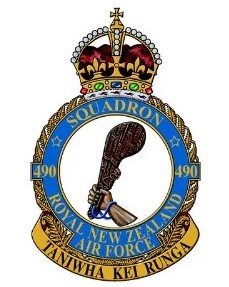
No. 490 (NZ) Squadron was an anti-submarine and maritime reconnaissance squadron of Coastal Command established for service during the Second World War. It was a New Zealand squadron formed under Article XV of the Empire Air Training Plan. Although many of its flying personnel were drawn from the Royal New Zealand Air Force, the squadron served under the operational and administrative command of the Royal Air Force.
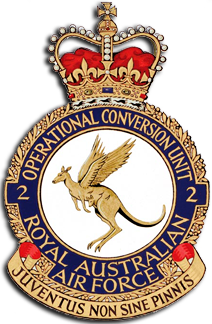
No. 2 Operational Conversion Unit is a fighter training unit of the Royal Australian Air Force (RAAF). Located at RAAF Base Williamtown, New South Wales, the unit trains pilots to operate the Lockheed Martin F-35 Lightning II. Pilots new to the F-35 enter No. 2 2OCU after first qualifying to fly fast jets at No. 79 Squadron and undertaking initial fighter combat instruction at No. 76 Squadron. Once qualified on the F-35, they are posted to one of No. 81 Wing's operational Hornet units, No. 3 Squadron, No. 75 Squadron or No. 77 Squadron.

No. 226 Operational Conversion Unit was a Royal Air Force Operational Conversion Unit which was active between 1946 and 1991.

No. 228 Operational Conversion Unit was a Royal Air Force Operational conversion unit. It was formed in No. 12 Group at RAF Leeming from Nos. 13 and 54 OTUs in 1947. The tasking of the OCU was the training of night fighter crews and its aircraft were the de Havilland Mosquito, Gloster Meteor, Bristol Brigand, and Gloster Javelin over the years. The OCU lasted until 1961 at Leeming when it was disbanded.
No. 231 Operational Conversion Unit was a Royal Air Force Operational conversion unit that disbanded during April 1993. It was active twice, initially between March 1947 and December 1949, before reforming in December 1951.

No. 5 Operational Training Unit was an operational training unit (OTU) of the Royal Australian Air Force. It was formed at Wagga Wagga, New South Wales, in October 1942 to train pilots and navigators for service in World War II. The unit was initially equipped with Bristol Beauforts and Beaufighters, and later received Douglas Bostons and de Havilland Mosquitos, among other types. No. 5 OTU was transferred to Tocumwal in October 1943, and then to Williamtown in mid-1944. It was reorganised as a fighter conversion unit flying P-51 Mustangs and CAC Wirraways in February 1946, and disbanded in July 1947.
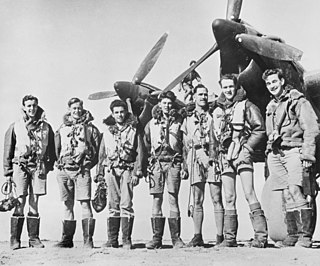
Article XV squadrons were Australian, Canadian, and New Zealand air force squadrons formed from graduates of the British Commonwealth Air Training Plan (1939) during World War II.
No. 236 Operational Conversion Unit was a Royal Air Force Operational Conversion Unit which was active between 1947 and 1992 and formed by re-numbering and merging different units.
No. 240 Operational Conversion Unit RAF is a former Royal Air Force Operational conversion unit which was formed by a series of mergers, it then became No. 27 Squadron RAF in 1993.
No. 234 Squadron RAF had a long career within the RAF, being operational on flying boats in World War I and on fighter aircraft in World War II. After the war it remained a fighter unit till 1957. In its last incarnation the squadron was in turn Operational Training Unit (OTU), Tactical Weapon Unit (TWU) and part of No. 4 Flying Training School RAF until finally disbanded in 1994.

No. 1 Operational Conversion Unit (No. 1 OCU) was an operational training unit of the Royal Australian Air Force (RAAF). Formed in January 1959 at RAAF Base Amberley, Queensland, its role was to convert pilots and navigators to the English Electric Canberra bombers flown by Nos. 1, 2 and 6 Squadrons. The unit's complement of Canberras included T.4 and Mk.21 dual-control trainers, and Mk.20 bombers. Originally a component of No. 82 Wing, No. 1 OCU became an independent unit at Amberley in April 1968, its focus being the provision of operationally ready pilots for service with No. 2 Squadron in the Vietnam War. No. 1 OCU was disbanded in June 1971, following the withdrawal of No. 2 Squadron from South-East Asia. By then the RAAF's only Canberra unit, No. 2 Squadron ran its own conversion courses before disbanding in 1982.
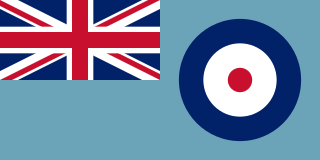
Flying Boat Training Squadron RAF is a former Squadron of the Royal Air Force which was operational between 1931 and 1956 through various names.











